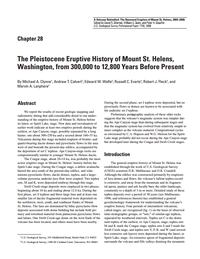The Pleistocene eruptive history of Mount St. Helens, Washington, from 300,000 to 12,800 years before present: Chapter 28 in A volcano rekindled: the renewed eruption of Mount St. Helens, 2004-2006
Links
- More information: USGS Index Page
- Document: Report
- Download citation as: RIS | Dublin Core
Abstract
We report the results of recent geologic mapping and radiometric dating that add considerable detail to our understanding of the eruptive history of Mount St. Helens before its latest, or Spirit Lake, stage. New data and reevaluation of earlier work indicate at least two eruptive periods during the earliest, or Ape Canyon, stage, possibly separated by a long hiatus: one about 300-250 ka and a second about 160–35 ka. Volcanism during this stage included eruption of biotite- and quartz-bearing dacite domes and pyroclastic flows in the area west of and beneath the present-day edifice, accompanied by the deposition of set C tephras. Ape Canyon-stage rocks are compositionally similar to younger Mount St. Helens dacite. The Cougar stage, about 28-18 ka, was probably the most active eruptive stage in Mount St. Helens’ history before the Spirit Lake stage. During the Cougar stage, a debris avalanche buried the area south of the present-day edifice, and voluminous pyroclastic flows, dacite domes, tephra, and a large volume pyroxene andesite lava flow were erupted. Two tephra sets, M and K, were deposited midway through this stage. Swift Creek-stage deposits were emplaced in two phases, beginning about 16 ka and ending about 12.8 ka. During the first phase, set S tephras and three large fans and at least one smaller fan of dacitic fragmental material were deposited on the northwest, west, south, and southeast flanks of Mount St. Helens. The fans are dominated by lithic pyroclastic-flow deposits associated with dome building but include both primary and reworked material from pumiceous pyroclastic flows and lahars. One Swift Creek-age dome on the west flank of the volcano has been located, and others must have been nearby. During the second phase, set J tephras were deposited, but no pyroclastic flows or domes are known to be associated with the andesitic set J tephras. Preliminary petrographic analysis of these older rocks suggests that the volcano’s magmatic system was simpler during the Ape Canyon stage than during subsequent stages and that the magmatic system has evolved from relatively simple to more complex as the volcano matured. Compositional cycles as envisioned by C.A. Hopson and W.G. Melson for the Spirit Lake stage probably did not occur during the Ape Canyon stage but developed later during the Cougar and Swift Creek stages.
Study Area
| Publication type | Report |
|---|---|
| Publication Subtype | USGS Numbered Series |
| Title | The Pleistocene eruptive history of Mount St. Helens, Washington, from 300,000 to 12,800 years before present |
| Series title | Professional Paper |
| Series number | 1750-28 |
| DOI | 10.3133/pp175028 |
| Year Published | 2008 |
| Language | English |
| Publisher | U.S. Geological Survey |
| Publisher location | Reston, VA |
| Contributing office(s) | Volcano Hazards Program |
| Description | 35 p. |
| Larger Work Type | Report |
| Larger Work Subtype | USGS Numbered Series |
| Larger Work Title | A volcano rekindled: the renewed eruption of Mount St. Helens, 2004-2006 (Professional Paper 1750) |
| First page | 593 |
| Last page | 627 |
| Country | United States |
| State | Washington |
| Other Geospatial | Mount St. Helens |


